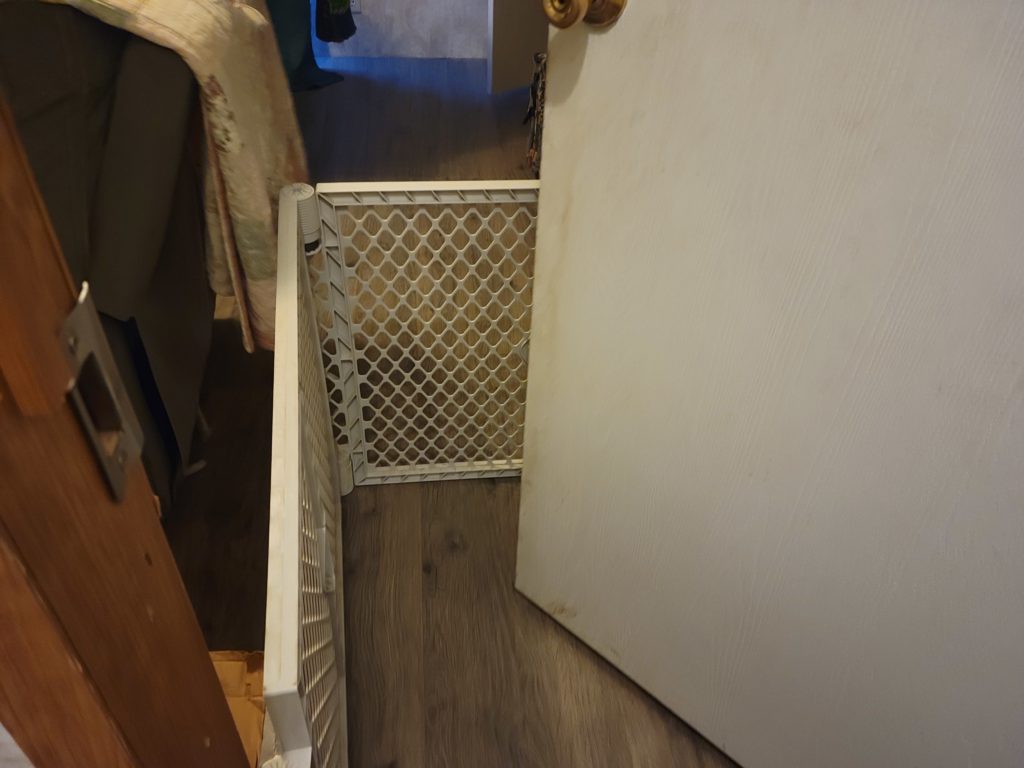So you have dogs who don’t get along (maybe we can say “yet”). You love these dogs. You’re devoted to making this work. You need some peace and quiet. You won’t put them into an already-overloaded rescue and shelter system that won’t do them any favors. You’re an amazing person! But you’re struggling. Because it’s truly one of the most stressful things to live with dogs who might harm one another. I see you.
You may have been told to “crate and rotate”. This is an easy way to say “crate one (or one pack) dog, let the other dog(s) out for socialization/potty time/freedom, and then switch.” My whole life is “crate and rotate”. While most dogs we have here are not remotely dog-aggressive, they still do not always get along. Between injuries, personality differences, play styles, learning history, the occasional illness, and aggression, we do a LOT of crate and rotate. Short, frequent durations in the crate can help generalize confinement and help a dog to understand that crating can be quite pleasant.
The first step in this practice is to crate or alone-train the dog. We have an article on crate training here. Alone training is EXACTLY the same procedure, but expands the dog’s confinement to a room rather than a crate. Either is fine. We’re teaching our dogs that being left alone should be a time to relax and chew appropriately or nap. This is a crucial skill that all dogs should learn. Instinct is on your side. Dogs are diurnal animals, which means that they’re mostly active in the morning and the evening and they sleep during the night and day. They naturally make a den and often prefer somewhere quiet and calm to take these naps.
Once your dog is crate (or alone) trained, we can start to rotate. For dogs who mostly get along, but cannot spend time physically interacting, crating in a communal area is acceptable. These dogs may pass one another, interact through the crate, see one another, and generally have a relationship. This is a good solution for young puppies who are new to the family, dogs with medical or training concerns that do not endanger the other house members, or dogs who are in the process of being introduced to a new family slowly, but cannot yet be loose.
Some dogs need to be crated in rooms apart from one another. These are often dogs in the beginning stages of crate training, who may be over-stimulated by the sight of another dog, dogs who have a history of aggression, or dogs who are suffering from a contagious illness. (In the case of contagious illnesses, please ensure that toys, water, food, bowls, and bedding are not shared.) Dogs each have their own preferences to the following: distance from other dogs/children/activity/doorways, covered vs uncovered crate, food/toys/chews in or out of the crate. Please consider these factors and decide or experiment to discover what will help your specific dogs feel safest and most at home.
We keep our dogs on a general 2-hour routine. This means that no matter how many packs we have here, all dogs must have access to water, potty breaks, toys, play, and affection at least every two hours. If we have two packs, we can easily leave one pack out for two hours before they’re put up and the next pack is allowed out for “people time”. If we have 4 packs, each pack gets 30 minutes of people time every two hours. We seldom encounter any “normal” households that have more than 2 packs, though there is the odd family with 3. Even with a 4 hour evening, 2 packs can easily get 2 hours each of interaction with their humans who work all day. A quick shuffle in the morning will allow adequate potty opportunities and another directly after work or before bed if there’s no one home during the day.
When keeping dogs separate, it is important to use at least two doors between dogs who might fight. If you’re using a bedroom, consider putting a wall-mounted gate in front of the bedroom door. A free-standing gate may be a better solution if dogs will fight through the door when they hear or smell one another. Ensure that any dog on the other side of the door is secured before entering the door and gate that separates the two dogs. The most important thing here is that there are always two doors between dogs: if I open the bedroom door while one dog is in the hall or even the kitchen, there’s only one gate between the dog in the bedroom and the one who is loose in another part of the house. Alternately, you can leash the loose dog and use a gate and tether or door and tether to ensure safety. It doesn’t take long, with some practice, to teach dogs to stay back from doors and gates. When the dogs AND the humans in the home are accustomed to this routine, dogs who are not instantly triggered by the sight of another dog may not require such stringent application of these rules. Until then, it is better to be safe than sorry.

While it may sound complicated, and it absolutely takes time and consistency to ensure that everyone in the home understands the new procedures, crating and rotating is not hard. Dogs who do not know each other, or who do not socialize together well, can and do live in the same home. It is important to be patient with yourself, your dogs, and others during this process. If you need help or encouragement, please reach out. We’re always here to help.
